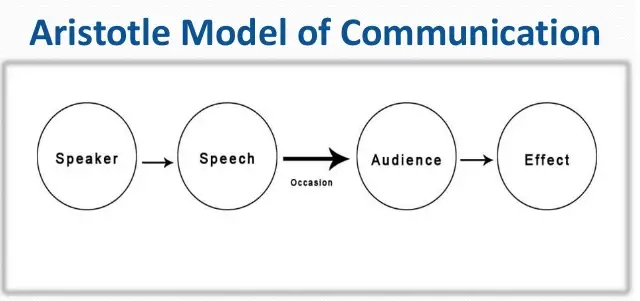Aristotle(384-322 B.C) was a Greek philosopher and writer born in Stagira, Northern Greece. He was also the teacher of Alexander the Great. He studied physics, logic, mathematics, etc.
While exploring the human nature scientifically, Aristotle developed a linear model of communication for oral communication known as Aristotle’s Model of Communication. This is considered as the first model of communication and was proposed before 300 B.C. It is also the is most widely accepted among all communication models.

Aristotle Model is mainly focused on speaker and speech. It can be broadly divided into 5 primary elements: Speaker, Speech, Occasion, Audience and Effect.
The Aristotle’s communication model is a speaker centered model as the speaker has the most important role in it and is the only one active. It is the speaker’s role to deliver a speech to the audience. The role of the audience is passive, influenced by the speech. This makes the communication process one way, from speaker to receiver.
The speaker must organize the speech beforehand, according to the target audience and situation (occasion). The speech must be prepared so that the audience be persuaded or influenced from the speech.
He believed “Rhetoric” is the study of communication and persuasion and different message or speech should be made for different audiences at different situations to get desired effects or to establish a propaganda. This model was highly used to develop public speaking skills and create a propaganda at that time so, it is less focused on intrapersonal or interpersonal communication.
Even if the model is speaker oriented and focuses on audience interaction in communication, there is no concept of feedbacks.
For instance, a politician (speaker) gives a speech to get votes from the civilians (audience) at the time of election (occasion). The civilians only vote if they are influenced by the things the politician says in his speech so the content must be very impressive to influence the mass and the speaker must design the message very carefully.
The speech must be clear as well as the speaker must have a very good non-verbal communication with the audience like eye contact. This example is a classic case of Aristotle Model of Communication depicting all the elements in the model.
Critical Elements of a Good Communicator
Aristotle has given 3 elements that must be present in a good communicator or public speaker. These elements are related to each other and they reinforce the other elements.
Ethos
Ethos is the characteristic which makes you credible in front of the audience. If there is no credibility, the audience will not believe in you and will not be persuaded by you. Expertise and positions also give credibility to a person.
For instance, the mass will not listen to the promises of a corrupt politician, but if a politician is known for his good deeds, there’s a high change his speech will be heard.
Pathos
If what you say matters to them and they can connect with it, then they will be more interested and they will think you are more credible. Emotional bonds will make the audience captivated and they feel the speaker is one of their own people.
For instance, if people of a village needs water and the politician tells them that he will help in building roads, the people will not get influenced but might be more influenced if he says he’ll build a dam for drinking water and irrigation.
Logos
Logos is logic. People believe in you only if they understand what you are trying to say. People find logic in everything. If there is no logic behind the speaker’s work or time, they do not want to get involved. Everybody has a sense of reason. You must present facts to the audience for them to believe in you.
For example, a presenter using factual data in an awareness program will attract the audience’s attention and will make them believe in the need of awareness in the particular matter.
Criticisms of Aristotle’s Model of Communication
There are few criticisms around this model. Some of them are
- There is no concept of feedback, it is one way from speaker to audience.
- There is no concept of communication failure like noise and barriers.
- This model can only be used in public speaking.
